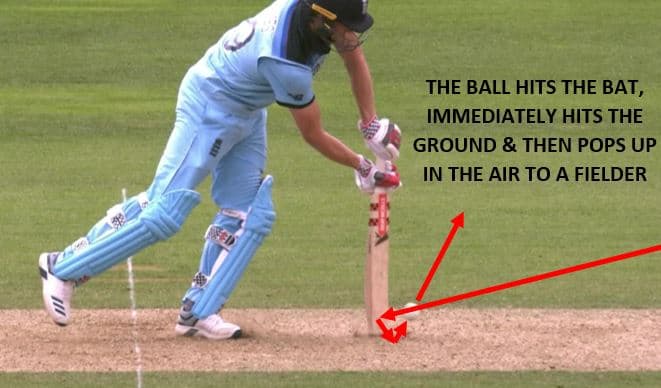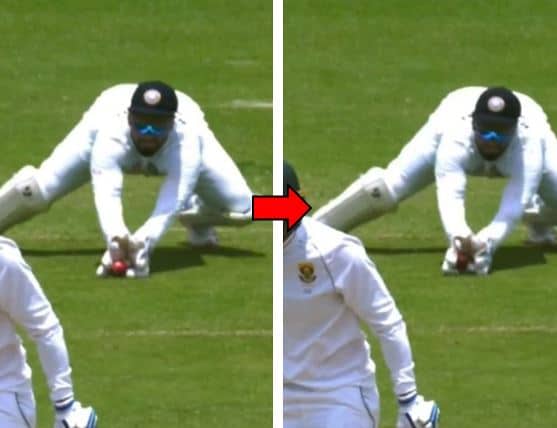When you’re sitting in a cricket crowd, or just watching on TV, it can often be hard to tell whether a batsman has hit the ball directly to a fielder or whether it has bounced first. I’ve lost count of the number of times that a batsman has absolutely smashed a shot to a fielder and a huge section of the crowd has started to celebrate, thinking that the batsman is out. The celebration quickly dies down when the crowd realises that no one on the fielding team is celebrating with them, and it becomes clear that the ball must have bounced beforehand.
When something like this happens, the commentators may start talking about it being a ‘bump ball’. To a lot of cricket spectators, the meaning of this phrase isn’t immediately obvious, so I thought I’d write a quick post that will explain it in a way that everyone can understand. If you continue reading this post you’ll learn what a bump ball is, and I’ll also answer a couple of other relevant questions. I hope you enjoy!
So, what is a bump ball in cricket?
A ‘bump ball’ is the term describing what happens when a batsman hits the ball directly into the ground and the ball is then caught by a fielder. In these situations, the ball hits the ground very fast, so it will appear to spectators that the batsman hit the ball straight to the fielder without it touching the floor.

Obviously, if the ball is hit directly to the fielder without bouncing, the batsman will be given out by the umpire. However, if the ball is a bump ball (meaning it touched the ground after it left the bat and before the fielder caught it), this means the batsman will need to be given not out. Because of how quickly and briefly the ball makes contact with the ground, it can often be very difficult for spectators, players and umpires to know whether a ball is a bump ball or if it really has been hit straight to a fielder. Umpires will usually have a gut feeling as to whether the batsman is out or not, and then the bowling side/batsmen can choose to challenge this via video replay if they wish. Decisions involving the possibility of bump balls often end up being decided by the 3rd umpire using slow motion replays.
When Do Bump Balls Usually Occur?
In my time watching cricket, I have seen bump balls occur the most when a bowler bowls a very full ball at a batsman – such as a yorker. If you don’t know what a yorker is, it’s basically a delivery that lands very close to the batsman’s feet (read more about it here). So, to stop the ball from hitting the stumps the batsman will often have to jam their bat down on to the ball. When they do this, sometimes the ball will travel into the ground very quickly and pop up in the air to be caught by a fielder standing close to the bat. If this happens fast enough, the bowler will start to appeal – and thus, the debate over whether it was a bump ball will begin.
What Is A Bump Catch?
If you’ve read this far, you should now understand that the term ‘bump ball’ is used to describe the process of batsman hitting the ball quickly into the ground and then the ball popping up towards a fielder. However, cricket wouldn’t be the sport that it is if it didn’t throw another slightly confusing term in the mix – and that’s where the term ‘bump catch’ comes in. Some people assume that bump ball and bump catch just mean the same thing – but this isn’t true!
The term ‘bump catch’ describes what happens when a fielder is diving forwards to take a catch and the ball bounces fractionally in front of their hands. In situations like this, it often looks like the ball is hitting the ground and being caught by the fielder at exactly the same time, so it’s very hard to determine whether the fielder caught the ball cleanly or not. If you’ve been watching cricket for a while, you’ll probably have seen a bump catch, because they seem to happen quite regularly!

When a catch like this is taken, the fielder will let the umpire know whether they think they caught the ball cleanly or not. The umpire will then refer the decision to the 3rd umpire in order to check whether the catch was completed. Even with the aid of video replay, it can be incredibly hard to tell whether a catch was clean or whether what you’re actually looking at is a bump catch. Therefore, the decision of the on-field umpire is vital. If the on-field umpire thinks the catch was taken cleanly, the 3rd umpire will only be looking for solid, irrefutable evidence that the ball hit the ground prior to being caught. If they can’t be sure either way, they will stick with the on-field decision. If the on-field umpire doesn’t think the catch was taken, then the video umpire is looking for cast iron proof that the ball did not touch the ground prior to being caught. Again, if there is any doubt, the 3rd umpire will stick with the on-field decision.
Conclusion
I hope this post has helped you to understand another one of cricket’s most confusing terms! I have answered a lot of questions like this here on the blog, so if you’re looking for similar information about more cricketing words and phrases – have a look at my general cricket questions page!
I also have plenty of technical tips that will help you to play the game better, so head over to the batting, bowling and fielding tips pages if you want to dive in to some of those!
